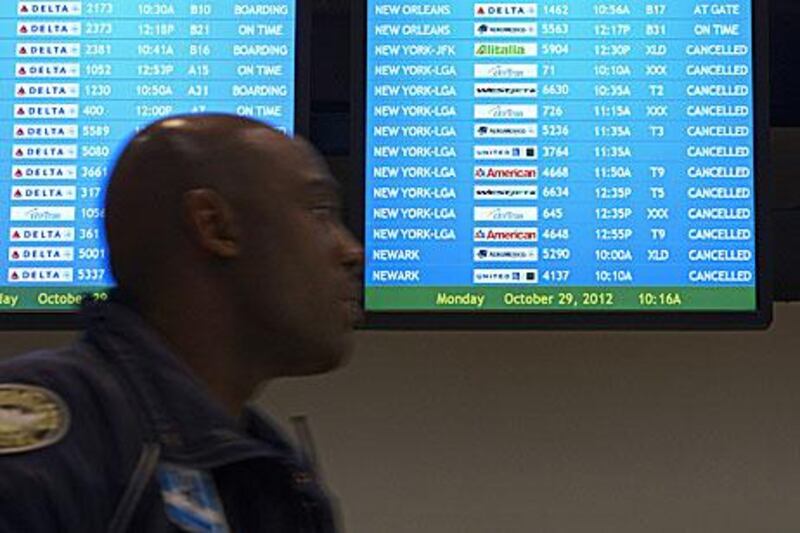AUSTIN, TEXAS // I should have suspected I'd be in trouble on Friday, when I flew from New York to Austin for a brief, two-day trip.
The media and Twitter were buzzing with speculation about Hurricane Sandy's strength. The rumours about evacuations, gale-force winds and torrential rains made it clear my return trip to New York - and my connecting flight to New Delhi - was in jeopardy.
But much of Friday was calm and pleasant, and a hurricane seemed too far away to worry about. Besides, as visitors to New York will know, when you are amid the steel-and-concrete skyscrapers of Manhattan, it is difficult to believe that anything from Mother Nature could damage this city.
I boarded my flight to Austin with little concern.
Recalling last year's Hurricane Irene, I should have known better. By Saturday afternoon, the "Frankenstorm" was all over the media, hinting at the frightening strangeness of the hurricane, whose official name of "Sandy" now seemed far too tame. Evacuations had been ordered; Michael Bloomberg, New York's mayor, had said that public transport would be shut down.
Many airlines had already cancelled flights and announced refund policies. But Air India, which was to take me from New York to New Delhi on Monday, decided instead to adopt a strategy of obfuscation. Its flights were "indefinitely delayed", which seemed to convey that its officials didn't want to begin rebook passengers unless the hurricane was ripping the roof off John F Kennedy International Airport.
On Sunday morning, a friend and I decided to leave Austin ahead of schedule, to at least make it into New York before the storm hit. I bought a US$430 ticket to New York via Dallas. My friend, more wisely, decided to fly to California and then to Singapore, where he lives.
He's home already, watching the eastern seaboard flood on television.
I hurried through security in Austin and made it onto the flight to Dallas with minutes to spare. New York was expected to receive only light to moderate wind and rain on Sunday evening, so I believed that, just by getting onto the plane, I was practically there.
Instead, when I sprinted to the gate for my Dallas-New York flight, I saw a mass of a hundred people standing around, looking forlorn. American Airlines had cancelled the flight and was trying to fit as many of my fellow passengers as possible onto a previous flight. I was Standby No 26; even as the woman at the counter took down my name, she said flatly: "You know, there's no way you are going to make it onto this flight."
She was right.
Neither did dozens of other people, some of whom seemed on the verge of tears at the turn of events. Mindy Kris, a garrulous blonde who said that she wanted only to "get back to her apartment before anything bad goes down", was frustrated. "I know that they're doing this as a precaution. But the weather is fine in New York right now. I'm sure our plane could fly there just fine." She was probably right; Sandy began laying into New York in earnest on Monday morning.
Stymied, I could only swap my ticket to New York with a ticket back to Austin; it felt like I had flown to Dallas just to eat lunch at the airport.
The next day, even as Texas was warm and bright, the images from New York and New Jersey looked grim and apocalyptic. Even the front-end of Sandy was enough to fill streets in low-lying areas with knee-deep water - and a full-moon high tide promised to be monstrous. A crane dangled dangerously from a Manhattan high-rise. On CNN, a reporter interviewed a Long Island man wearing scuba gear. Roads and subway stations were deserted, turning the City That Never Sleeps into a ghost town. The skyline, otherwise so inspiring, looked puny under the mass of thick black clouds.
The language surrounding the storm grew more forbidding as well. Authorities had now begun to describe Sandy as one of the largest storms on record. Rick Knabb, the director of the National Oceanic and Atmospheric Administration, called it a "multihazard event". Dannel Malloy, the governor of Connecticut, warned in a Monday morning briefing: "Stay home. Let me repeat that: stay home."
Meanwhile, Air India's helpline continued to be helpless. Three hours before my flight to New Delhi was slated to take off, I learnt during my fifth call of the day that it had been cancelled. A "rescheduling team" was apparently working on putting us on other seats. When one agent said that he could offer me, "right away", a seat on a flight to New Delhi in two weeks, I asked him, in rather impolite terms, to find me a seat this week. He shot back with the now-familiar Air India customer service response: "Please call back later to find out, sir." In the storm of the century, I discovered, the only really immovable object was the stubbornness of Air India customer service.
ssubramanian@thenational.ae





